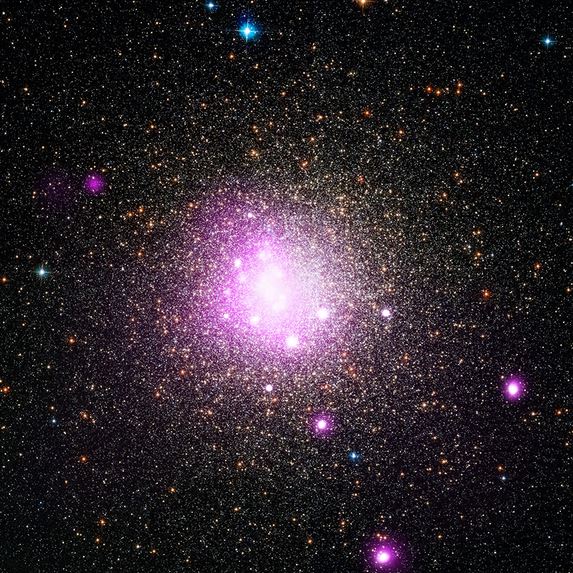A white dwarf star was seen tearing a planet apart at the edge of our galaxy, the Milky Way, by astronomers. A white dwarf star is an old star that has run out of nuclear fuel, while its mass is comparable to that of the Sun, it may be no bigger in volume than the Earth, meaning it has an incredible gravitational force for its size.
A team of Italian scientists used several telescopes, including NASA’s Changra X-ray Observatory, and found evidence that a white star may have torn apart a planet as it came too close.
They published their findings in the academic journal Monthly Notices of the Royal Astronomical Society (citation below).

NGC 6388, where a white dwarf star appeared to have torn a planet apart. (Image: chandra.harvard.edu)
White dwarf star’s gravity
How can a white dwarf star, which is only about the size of our planet, tear another planet apart? The answer, say the scientists, is gravity.
When a star reaches the white dwarf stage, nearly all its material is condensed into a radius one hundredth its original size.
This means that for close encounters, the small star’s gravitational pull and the associated tides, caused by the difference in gravity’s pull on the far and near side of the planet, are dramatically enhanced.
The gravity on a white dwarf’s surface, for example, is more than ten thousand times greater that the gravity at the surface of our Sun.
Melania Del Santo of the National Institute for Astrophysics (INAF), IASF-Palermo, Italy, and colleagues used the ESA’s INTErnational Gamma-Ray Astrophysics Laboratory (INTEGRAL) to discover a new X-ray source close to the center of the globular cluster NGC 6388.
At first they though a black hole was the culprit
Optical observations had suggested that an intermediate-mass black hole with the mass-equivalent of several hundred Suns resided at the center of NGC 6388. INTEGRAL’s X-ray detection raised the possibility that the X-rays were produced by hot gas swirling in the direction of an intermediate-mass black hole.
With Chandra’s super X-ray vision, the scientists followed-up X-ray observations and determined that they were not coming from a putative black hole at the center of the cluster, but rather from a location slightly off to one side.
A new composite image shows NGC 6388 with visible light from the Hubble Space Telescope in blue, green and red, and X-rays detected by Chandra in pink, with several of the stars appearing to be orange or white. Overlapping X-ray sources and stars close to the cluster’s center also cause the image to appear white.
After ruling out the central black hole as the potential X-ray source, the scientists continued hunting for clues about the source in NGC 6388. After the discovery by INTEGRAL, the source was monitored with the X-ray telescope on board NASA’s Swift Gamma Ray burst mission.
During the period of Swift observations the source got dimmer. The rate at which the X-rays dimmed agreed with theoretical models of a planet’s disruption by the gravitational tidal forces of a white dwarf.
Planet torn apart from intense tidal forces
NASA’s Changra X-ray Observatory wrote:
“In these models, a planet is first pulled away from its parent star by the gravity of the dense concentration of stars in a globular cluster. When such a planet passes too close to a white dwarf, it can be torn apart by the intense tidal forces of the white dwarf.”
“The planetary debris is then heated and glows in X-rays as it falls onto the white dwarf. The observed amount of X-rays emitted at different energies agrees with expectations for a tidal disruption event.”
According to the scientists’ estimates, the white dwarf has about 1.4 times the mass of our Sun, while the destroyed planet would have contained approximately one-third the mass of Earth.
While evidence that tidal disruption destroyed the planet is not 100% compelling, the argument for it was strengthened when scientists used data from the multiple telescopes to help rule out other possible explanations for the detected X-rays.
The source is far too faint in radio waves to be part of a binary system (system with two stars) with a stellar-mass black hole. The authors added that the source does not show some of the hallmark features of a binary containing a neutron star, such as rapid-X-ray busts or pulsations.
Citation: “The puzzling source IGR J17361–4441 in NGC 6388: a possible planetary tidal disruption event,” M. Del Santo, A. A. Nucita, G. Lodato, L. Manni, F. De Paolis, J. Farihi, G. De Cesare and A. Segreto. Monthly Notices of the Royal Astronomical Society. Published 13 August 2014. DOI: 10.1093/mnras/stu1436.
